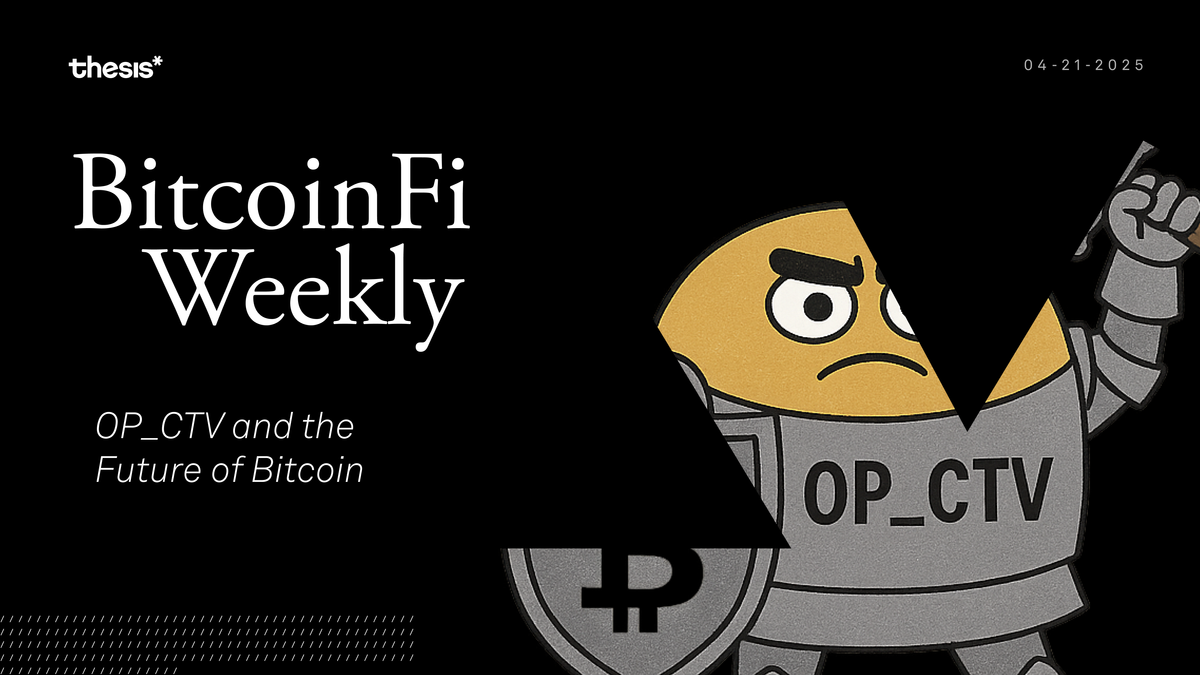OP_CTV and the Future of Bitcoin
Bitcoin is evolving fast. This week’s BitcoinFi Weekly covers OP_CTV’s impact, BitVM-powered bridges like Clementine, Tether’s decentralized mining move, and Arkade’s wallet POC. From scalability to sovereignty, Bitcoin’s future is shifting from theory to action.

Welcome to BitcoinFi Weekly. We cover where people use their BTC and what is changing in the Bitcoin world.
One of my favorite euphemisms is: where there's a will, there's a way. This week’s edition arrives in the middle of what feels like a shift. After OP_NEXT, it feels like something has cracked open. A prototype wallet running new coordination logic hits mainnet. A whitepaper nails down a real BitVM bridge. A mining giant stakes its future on decentralized block construction. Even the ghosts of old banking collapses are surfacing with sharper definition. It’s clear: the battle over what Bitcoin can be is moving out of the theoretical and into the practical. There’s a kind of optimism here. Not the manic kind, but the durable kind. If Bitcoin still feels slow or inflexible, this week’s headlines say otherwise. Let’s dive in.
Here’s this week’s rundown:
🛡️ Feature piece: OP_CTV, explained
📜 Citrea Unveils Clementine Whitepaper
🌊 Tether to Deploy Hashrate on OCEAN
🏦 The Truth Behind Signature Bank’s Demise
🧪 Ark Labs showcases wallet POC
Feature Piece: OP_CTV, explained
Bitcoin is famously reluctant to change. However, every now and then, a particular BIP comes around that claims to introduce profound consequences. Enter OP_CHECKTEMPLATEVERIFY, known simply as OP_CTV.
First introduced by Jeremy Rubin, OP_CTV enables covenants, or a special type of script that restricts how coins can be spent in the future. Covenants aren't new in theory, but they've long been complex and impractical. It works by committing to a hash of the next transaction that spends it. If the transaction doesn't match this hash, it's considered invalid. The hash includes specific transaction properties like version, locktime, outputs, and more.
It could be thought of as setting strict guardrails around your coins: you specify exactly how they'll move, and that's the only way they'll ever move. No surprises, no detours. This might sound restrictive, but it means more control and efficiency in practice. Consider payment congestion. Right now, sending Bitcoin in large batches (i.e., an exchange distributing withdrawals) can clog the network when fees spike. With OP_CTV, a sender can pre-commit to a transaction that distributes funds gradually, whenever fees subside. One initial transaction, confirmed once, effectively locks in future payments without additional onchain congestion.OP_CTV also affects the Lightning Network, altering channel factories. Lightning Network users typically open channels one by one, paying hefty fees when traffic peaks. OP_CTV would let multiple users combine their funds into a single transaction, creating a batch of channels in one go. Channel updates become quicker, cheaper, and less interactive.
Vaults are another intriguing use. Right now, securing large amounts of Bitcoin demands complex, error-prone arrangements involving ephemeral keys. These are temporary keys you generate, use, and then carefully delete. Mess up once, and your vault could fail catastrophically. OP_CTV sidesteps this complexity by replacing keys with simple transaction templates. Predefined spending conditions make vault security straightforward and virtually foolproof.
Yet, OP_CTV isn't without its critics. Some argue it's too limited, a stepping stone rather than a full solution. They fear adopting it now might mean settling for "good enough" when more powerful covenant techniques, like OP_TXHASH, could follow. Others worry it introduces complexity to fee estimation, as pre-committing to transactions means guessing fees well in advance, possibly requiring awkward external fee payments later. Alternatives like SIGHASH_ANYPREVOUT offer different, potentially more flexible paths. These competing solutions might replicate much of OP_CTV’s functionality, though perhaps less efficiently or with greater complexity.
OP_CTV won’t radically alter Bitcoin overnight. But it quietly introduces powerful, streamlined mechanisms that could simplify and strengthen how Bitcoin scales, secures, and functions day-to-day. Combining CTV with CSFS (CHECKSIGFROMSTACK) would provide lean, secure contract capabilities without exposing Bitcoin to increased MEV risks that might come with other upgrades like OP_CAT.
Needless to say, OP_CTV certainly merits keeping an eye on.
BitcoinFi Updates
Citrea Unveils Clementine Whitepaper
Citrea has introduced Clementine, a new Bitcoin rollup bridge designed to securely connect Bitcoin with programmable second layers through ZK proofs and BitVM2. Clementine tackles Bitcoin’s inherent scripting limitations by using a provably secure Bitcoin light client implemented directly on Bitcoin, enabling trust-minimized peg-outs without heavy onchain computation.
At a high level, Clementine works like this: when users want their BTC back from Citrea's rollup, they burn cBTC and specify an incomplete payout transaction. Operators front the actual BTC to users immediately by completing and posting this transaction onchain. To get reimbursed, operators post a KickOff transaction containing commitments to the Bitcoin chain state. This kickoff starts a verification window where Watchtowers and Challengers can contest fraudulent claims. The protocol divides time into "payoff rounds" where operators process multiple peg-outs with fixed collateral.
Key to Clementine is its use of collateral efficiency: operators reuse the same capital across transactions by finalizing rounds sequentially. When malfeasance occurs, a single successful challenge slashes all an operator's pending reimbursements, creating powerful incentives for honest behavior. Remarkably, Clementine reduces capital requirements by 125× through the use of zero-value outputs, using BitVM's capability to run zk-SNARK verifiers directly within Bitcoin script, and implements a "covenant emulation" system using pre-signed transactions.
Disputes trigger a minimal on-chain verification process managed by BitVM2’s off-chain computational efficiency, ensuring economic safety without compromising security assumptions. Clementine operates securely under Bitcoin's traditional assumptions (less than 50% adversarial hash rate). The Clementine whitepaper is the first and currently only detailed documentation of applying BitVM in a bridge architecture, offering concrete, well-defined mechanisms for achieving security and efficiency in a fully trust-minimized bridge design.
Tether to Deploy Hashrate on OCEAN
Tether has announced plans to direct its “existing and future” hashrate to OCEAN, a decentralized Bitcoin mining pool. The move is yet another step in Tether’s broader $500 million push into mining, which includes building infrastructure and acquiring stakes in operations across Latin America and beyond.OCEAN distinguishes itself from traditional mining pools by using the open-source DATUM protocol, which enables individual miners to construct their own block templates. This design reduces reliance on centralized coordinators and increases resistance to transaction censorship. Tether will roll out DATUM Gateway software across its mining operations, enabling high-performance mining even in low-bandwidth conditions.
Tether has slowly but surely been expanding its Bitcoin exposure, now holding over $7.8 billion in BTC and ranking as the sixth-largest known holder globally.
However, the partnership has drawn scrutiny due to Luke Dashjr’s polarizing views. In addition to his technical credentials, Dashjr is known for his strong opposition to Bitcoin-based applications like inscriptions (Bitcoin-native NFTs) and has publicly sought to censor these transactions through OCEAN. This has raised concerns among parts of the Bitcoin community, particularly those advocating for broader use cases atop the base layer.
Tether, for its part, framed the move as a commitment to decentralization and operational independence. Whether this deepening alignment with OCEAN and its values will influence Bitcoin mining norms at large remains to be seen.
The Truth Behind Signature Bank’s Demise
In a detailed report, Nic Carter presents a chilling narrative around the 2023 collapse of Signature Bank, arguing that the bank was not only solvent at the time of its seizure but was purposefully shuttered to justify invoking the Systemic Risk Exception: a mechanism needed to bail out uninsured depositors at Silicon Valley Bank (SVB).FDIC Chair Martin Gruenberg, installed with Elizabeth Warren's backing, rejected credible buyout offers for SVB, worsening the crisis. Only after a call from Nancy Pelosi (whose husband’s business was exposed to SVB) did the administration move to guarantee deposits. To meet the “systemic” threshold required for the exception, regulators seized Signature, a New York-based institution with a stable depositor base and sufficient liquidity lines it was never allowed to access.
Carter’s reporting suggests that Signature, which had a moderate crypto exposure through its SigNet platform, was not in the same risk category as SVB or Silvergate, but was targeted partly because of its crypto ties. Internal attempts by Signature leadership to secure liquidity through the Fed were ignored, and the NYDFS ultimately seized the bank under FDIC pressure. The FDIC then invoked the Systemic Risk Exception just 47 minutes later. The seizure caused billions in unnecessary losses and led to litigation against former executives, actions Carter frames as retroactive cover for a politically motivated decision.
The broader implication is that regulators exploited the crisis to accelerate a preexisting anti-crypto agenda (Operation Choke Point 2.0) by eliminating key crypto-friendly banks under the guise of systemic risk management. Under new leadership, the FDIC is now retreating from that posture, but legacy staff continue efforts to legitimize what he contends was a deeply questionable regulatory maneuver. Signature, in Carter’s view, “died for the sins of SVB.” For more, read the full Pirate Wires article here.
Ark Labs Showcases Wallet POC
At OP_NEXT this past weekend, Ark Labs demoed Arkade, a prototype wallet built on the Ark protocol. While the wallet itself is just a proof-of-concept, the point was more philosophical than product-driven: Arkade demonstrates that a new class of Bitcoin applications is possible today, using only Bitcoin’s current consensus rules. Unlike many proposed layer-2 protocols that hinge on soft forks or future upgrades, Ark’s approach is to deliver real utility with the tools Bitcoin already provides.
Ark is not a Lightning alternative but something more modular, enabling flexible coordination mechanisms and application logic that work off-chain, yet remain grounded in Bitcoin’s base layer. Arkade represents a tangible glimpse of that broader vision: a wallet platform that supports both onchain and off-chain transactions via a TypeScript SDK. Ark Labs is positioning Ark as a foundation for new UX and developer primitives that Bitcoin hasn’t seen before.
Closing Thoughts
From all appearances, it would seem that Bitcoin is perched, standing at the edge of a great unfinished cathedral. We’ve often been led to believe that Bitcoin is stubborn, resistant to change. But the reality these days points to the inverse. Bitcoin reveals itself again this week as a creature not of inertia, but of deep intention. That its best days are indeed in front of it. OP_CTV introduces practical covenant logic that simplifies batching, vaults, and channel factories without needing sweeping consensus changes. CSFS promises more expressive contracts with minimal complexity.
The pieces are starting to connect: clearer bridges, more censorship-resistant mining, off-chain protocols that actually work. POC wallets like Arkade prove coordination is possible without new opcodes. Clementine shows that bridges can be both secure and capital-efficient using tools like BitVM2 and zkSNARKs. Even mining, long considered ossified, is shifting toward more open, decentralized architectures. It would appear, for all intents and purposes, that we are well underway in the Bitcoin renaissance.
Thank you for tuning in to this week’s BitcoinFi Weekly. See you next week.
If there's a topic you’d like us to cover or have questions, reach out at [email protected].





